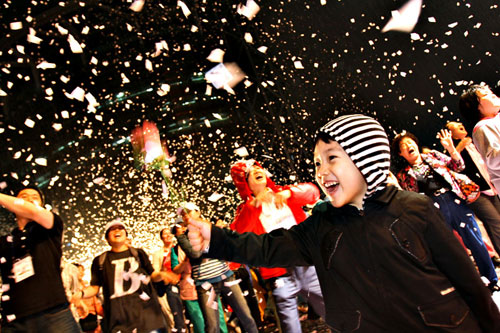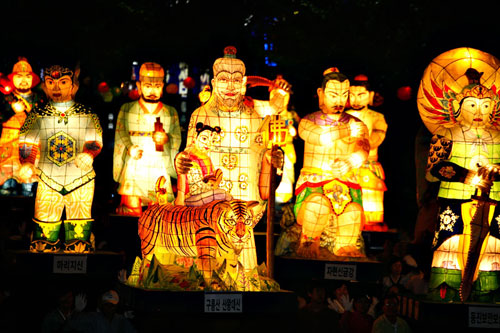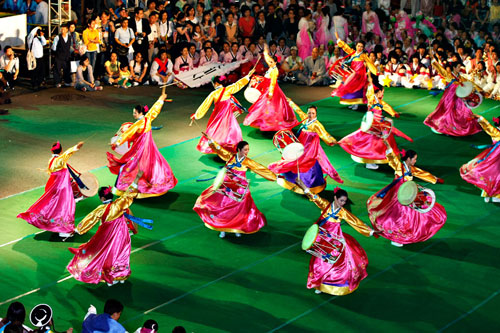 The Lotus Lantern Festival (Photo courtesy of Festival organizers)
The Lotus Lantern Festival (Photo courtesy of Festival organizers)
Can you tell it’s festival season in Korea?
Well, if this is news to you, starting on April 24, Korea’s Buddhist community will celebrate the birth of the Buddha with an extravagant, 11-day festival of light called the Lotus Lantern Festival (연등축제). Buddha’s birthday is celebrated on the eighth day of the fourth lunar month, which, this year falls on May 2nd.
 100,000 colorful lanterns in many shapes and sizes will parade through downtown Seoul (Photo courtesy of Festival organizers).
100,000 colorful lanterns in many shapes and sizes will parade through downtown Seoul (Photo courtesy of Festival organizers).
If you’ve been in Seoul lately, no doubt you’ve noticed the strings of colorful paper lanterns that line the city’s major streets, not to mention the enormous lanterns that re decorating the Cheonggyecheon (청계천), the stream that runs through central Seoul.But those are just a precursor to an expected 100,000 handmade lanterns that will decorate the city this weekend. Lanterns have a long history in Korea, with records going back as far as the Silla Kingdom. Buddhism reached its zenith as the state religion of the Goryeo Dynasty before it was supplanted by the Joseon Dynasty’s embrace of Confucianism.
 Jogye Temple in downtown Seoul will feature a ceiling of paper lanterns.
Jogye Temple in downtown Seoul will feature a ceiling of paper lanterns.
Today, about one-quarter of Koreans are Buddhist, and the Jogye Order is Korea’s largest Buddhist sect. As festival hosts, they will kick off the annual celebration this Friday, when Bongeunsa Temple (봉은사) near the COEX Center will open a special exhibit of lanterns made from Korea’s exquisite traditional paper called hanji (한지). Events continue on Saturday evening, when the popular central Seoul neighborhood of Insa-dong (인사동) will host Yeondeungnori (연등놀이), an “eve celebration” featuring Korean folk music and dance.
 The Lotus Lantern Festival features traditional dance and music (Photo courtesy of Festival organizers).
The Lotus Lantern Festival features traditional dance and music (Photo courtesy of Festival organizers).
But the big show starts on Sunday at noon, when the streets in front of Jogyesa Temple (조계사) in downtown Seoul are filled with thousands of people enjoying food and activities. Some 100 booths will offer the chance to make a Buddhist rosary, try a rubbing of a Buddhist sutra, or even make your own lantern – which is said to help one attain enlightenment in the next life. Another area will offer a glimpse into the rich Buddhist culture of Korea’s Asian neighbors, like Japan, Sri Lanka and Indonesia.
 “Temple Food” has become popular for its healthy content and simple preparation (Photo courtesy of Festival organizers).
“Temple Food” has become popular for its healthy content and simple preparation (Photo courtesy of Festival organizers).
Of course, no festival is complete without food, and the Lotus Lantern Festival will include booths specializing in “Temple Food,” a culinary art practiced since Korea’s Three Kingdoms period. The monks’ cuisine is healthy and simply prepared. Typical ingredients include home-grown vegetables, but do not include meat or five pungent ingredients said to bring on lust and bad luck, which are: garlic, leeks, green onion, wild rocambole and squill (I don’t know what that is).
 The parade starts at Dongguk University Station and ends outside Jogye Temple, near Jonggak Station (Photo courtesy of Festival organizers).
The parade starts at Dongguk University Station and ends outside Jogye Temple, near Jonggak Station (Photo courtesy of Festival organizers).
At dusk the street festival makes way for the lantern parade, which is said to be Seoul’s largest street procession. From Dongguk University Station to Dongdaemun and Jogyesa Temple, Seoul’s night sky will be lit by thousands of lanterns in the shapes of dragons, pagodas, phoenixes, and, of course, lotuses. At about 9:30 pm, everything culminates with the Daedong Celebration (대동한마당). Meaning “being together,” the final event of singing and dancing at the Jonggak intersection reaches a finale at 11 pm when revelers are showered by pink lotus petals.
 One particularly large lantern I captured at last year’s festival.
One particularly large lantern I captured at last year’s festival.
Although not formally part of the festivities, on May 2, a special service will be held at 10 am at local temples followed by a final lantern service at 6 pm. Bongeunsa Temple’s traditional lantern exhibit will close on May 4.

More Information:
Lotus Lantern Festival Official Site (in English)
Jogye Sect of Korean Buddhism Official Site (in English)
Getting There:
→ To visit the traditional lantern exhibition at Bongeunsa Temple, take subway 2 to Samseong Station (exit #2).
→ To reach the Yeondeungnori eve celebration, take line 1 to Jonggak Station or line 3 to Anguk Station.
→ The main area of the Lantern Parade can be reached by taking subway lines 1, 3 and 5 to Jongno
3-ga Station or line 1’s
Jonggak Station and
Jongno 5-ga Station.Click here for a detailed, interactive map of festival locations and the parade route via Google Maps.
All events are free.
(A version of this text aired on KBS World Radio on April 22, 2009.)



Hi there,
Thanks for your quick response to my comment about Namhae. Appreciate the effort that you put into all the pics, captions, traveller tips and so on. Love the pretty night shots of the lanterns. In Malaysia, Buddhists celebrate Wesak Day ( ie Buddha’s Birthday) but I think we don’t do such a splendid job on lanterns. Is it too late for you to cover the making of those impressively shaped lanterns which look like mythical figures? Who do they represent or symbolise? Always like behind the scenes shots. ( OR are the lanterns made in China????)
What happens to the lanterns after the festival? Are they recycled or burnt in some ritual?
In 2007, I stumbled across in a small temple in Jinju some ajummas who were assembling the lotus lanterns in preparation for the festival. Quite time-consuming to stick with starch the individual pink lotus petals or green leaves onto the lantern frames but a lot of fun. ( But then again, I only did it for about half an hour. ) Unfortunately, I ran out of film so have to depend on my flagging memory to recall that experience.
Wishing those who are lucky enough to be travelling around Korea this spring many happy moments discovering the less obvious charms of Korea.
SL
By: Anonymous on 22 April 2009
at 12:49
Hi there,
A closer look at lantern making is a great idea. Although too late for this year, it would be a nice post for next year, since the general information about the festival will stay the same. Thanks for the suggestion!
Best, Matt
By: Matt Kelley on 29 April 2009
at 10:38